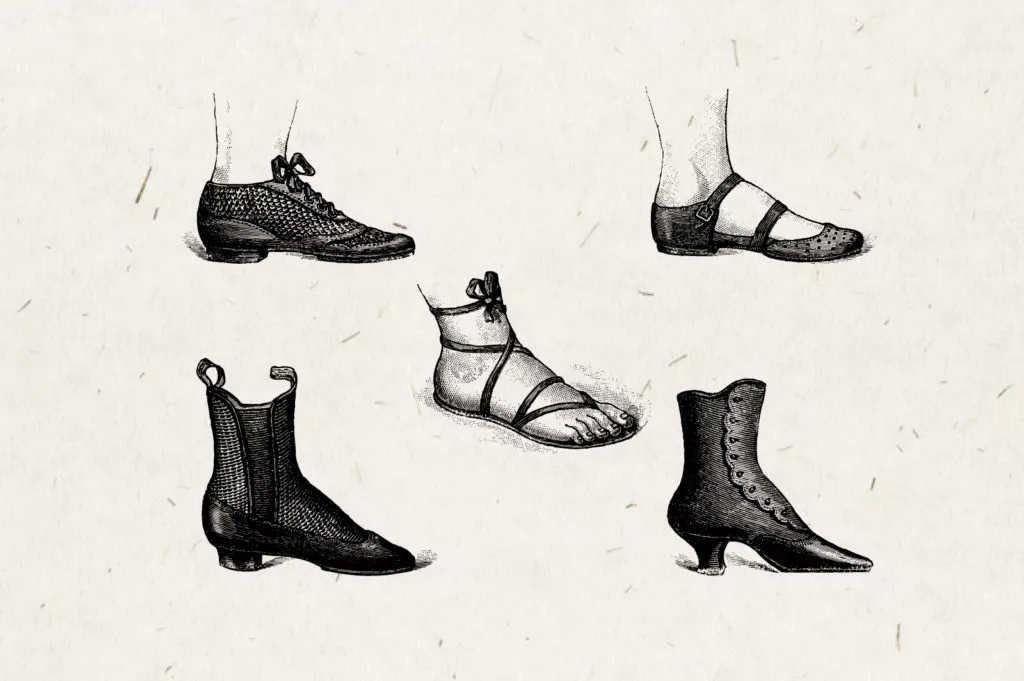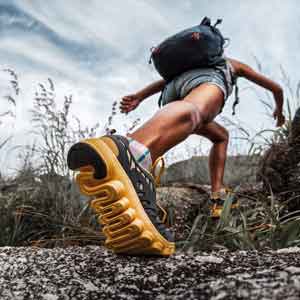After millennia of shoe laces and buckles, welcome to the age of plastic fasteners
When we see how long people have been wearing shoes and other footwear, it may be surprising how long it has taken for plastic fastener manufacturing technology to improve on the humble shoelaces, straps, buckles and buttons used through the ages.
Table of Contents
Fortunately today we can choose from better materials and designs than our ancestors ever could. This has enabled the development of newer, better materials for manufacturing shoes as well as setting off a revolution in fastener design.
Footwear Through The Ages

The Victoria & Albert museum in London has a huge collection of shoes, the oldest are overshoes worn by the Ancient Egyptians over 3,500 years ago, made of reeds and fastened with reed straps. You might think we’ve come a long way from those simple beginnings to get to modern composite shoes with plastic fasteners, and we have, but surprisingly recently.
Although styles and fashions have changed through the ages, it was more than 3,000 years before Dunlop managed to bond canvas uppers to rubber soles, which opened the door to much more innovative designs than were previously possible. Making composites and laminates from fabrics and rubber was the first step towards the modern athletic shoe.
These early innovators still fastened their shoes with laces or buttons. Elastic sided boots were only patented in 1837, so innovations in shoe fasteners was very slow. Advances in material technology led to an explosion of styles and types of footwear in the 20th Century, and the increasing popularity of athletic and sports footwear.
The release, and phenomenal success, of the Nike Cortez in 1972 perhaps marks the widespread adoption of the ‘sneaker’ as crossover athletic and leisure-wear. This expanded the market for athletic shoes as they became must-have fashion accessories. Despite a futuristic look and innovative materials, the Cortez was still fastened with shoelaces.
Footwear Fasteners: Elastic, Buckles & Laces

Looking back 3,500 years we find reed shoes fastened with reed straps, and historically many shoe designs have been slip-on without any fasteners at all. We now know, however, that securely fastened shoes are more comfortable and safer to wear.
What Was Used Before Shoelaces?
- Straps
- Hooks & Eyes
- Buckles
- Buttons
Straps and laces have been the most common historical methods for keeping your footwear on your feet. Buckles and buttons appeared from time to time, often as a style element and not because they are the best way to fasten shoes. Elastic has also featured for convenience, but it can’t provide a secure fit.
How have shoe styles changed?
- Rounded toes
- Square toes
- Forked toes
- Left & Right shoes are a recent invention
Footwear has come in all styles and forms, with rounded toes, square toes, and even forked toe shapes, but most have been fastened with laces. If your shoes were joined together at the heels you would probably still be using laces to keep them on your feet. Shoes did not start to be made in left and right versions until the 1830s!
What about lace locks?
The most recent innovation in shoe fastening is the lace lock, which keeps your shoes on with maximum security and minimal fuss whether they are leisure shoes or high performance athletic footwear. Shoelaces can easily come undone, and this happens surprisingly rapidly. Lace locks provide a secure and easy method of keeping laces comfortably tight, but easy to release.
The Footwear Of Tomorrow… Today

Today’s advanced shoe designs call for equally advanced fasteners. Plastic fastener manufacturers have responded to the demand for high performance fasteners by finding ways to improve security without making it more difficult to fasten your shoes.
As a plastic fastener manufacturer with a long history of breakthroughs from our in-house research and development, Nifco have led the fastener revolution with our patented lace lock designs. Nifco lace locks are the ultimate in footwear fastening, whether you are going shopping or walking up a mountain.
This is why Nifco lace locks are now part of the standard equipment for many global brands manufacturing high performance athletic shoes. Easy to lock and easy to open, ergonomically designed for maximum grip with minimal effort.
Nifco, the best fit solution for people and planet









